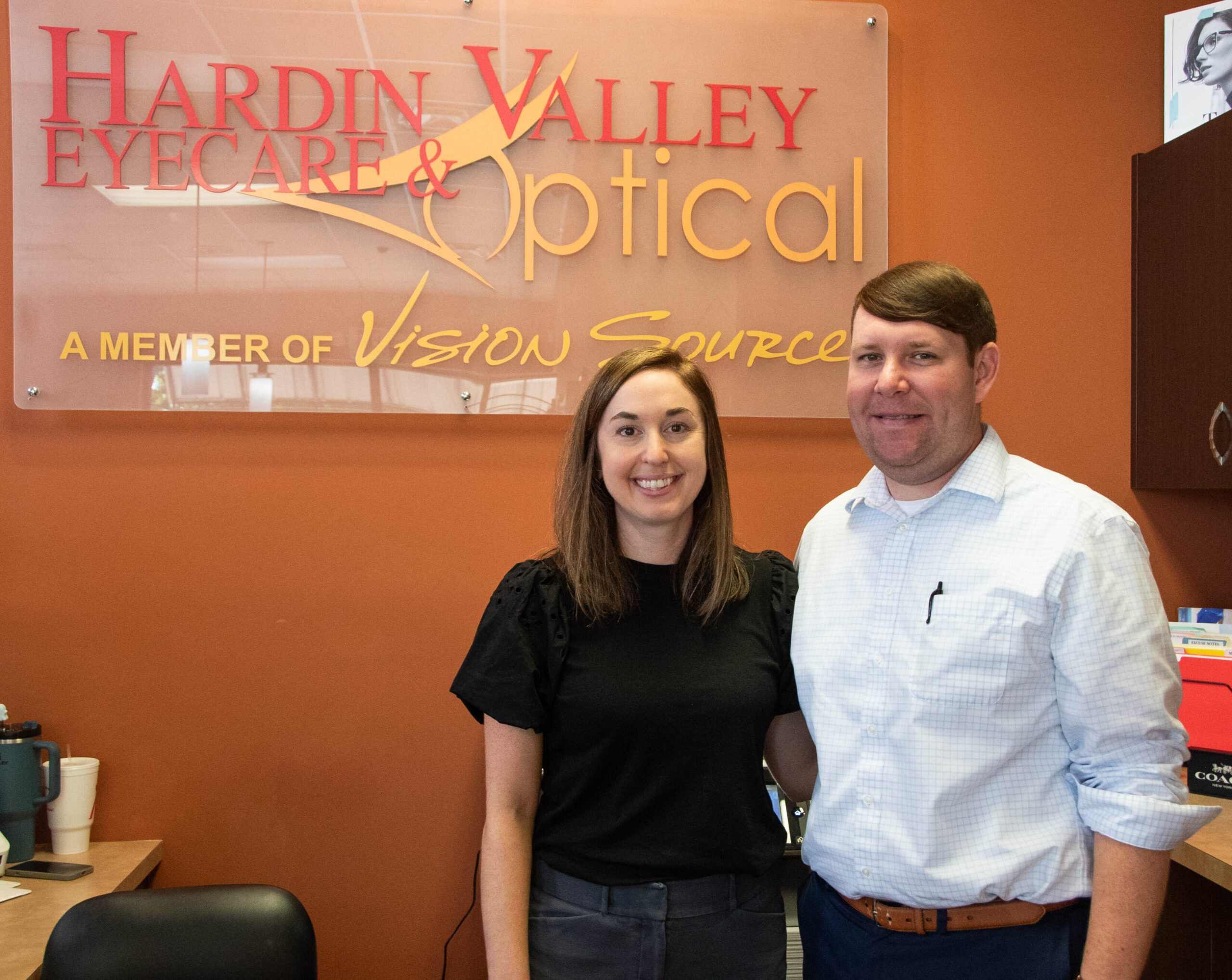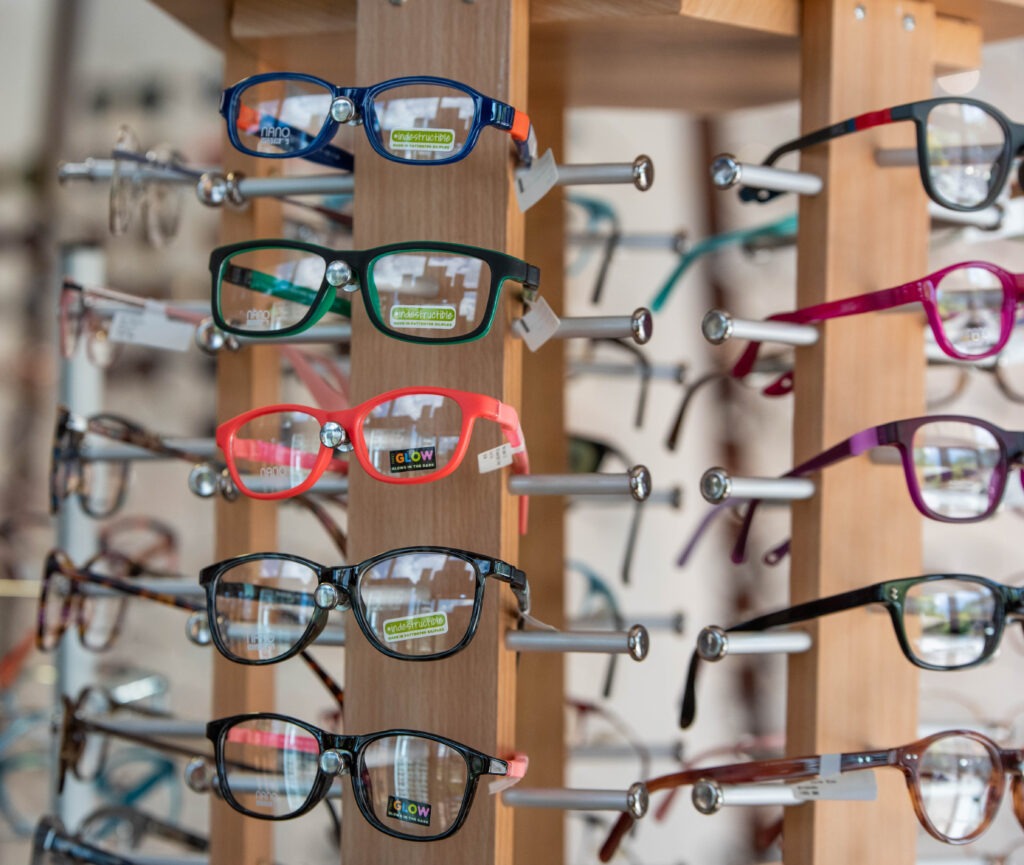Children’s Eye Care in Knoxville, TN
Knoxville Children’s Eye Care

Hardin Valley Eyecare & Optical has been serving Hardin Valley and the greater Knoxville area since 2009. Dr. Travis Thompson and Dr. Catherine Abbott provide top-notch children’s eye care to kids of all ages.
We use the latest, state-of-the-art diagnostic tools to detect and provide solutions to a broad range of eye:
- Problems
- Diseases
- Injuries
Dr. Thompson, Dr. Abbott, and the rest of our team strive to provide the best vision care for your children.
What to Expect During an Eye Exam for Kids
When it comes to children’s eye care, an optometrist’s approach to eye exams for kids can vary based on age. For example, older kids who can speak or read can communicate much more easily than a toddler.
Eye Exams for Toddlers
The focus of toddlers’ eye exams is to assess their:
- Responsiveness to changes in lighting
- Eye alignment
- Eye movement quality
Our eye doctors also check for eye problems such as:
- Astigmatism is when a child's eye has an irregular shape. This can result in blurred vision for both near and distant objects.
- Farsightedness (hyperopia) causes up-close objects to appear blurry while distant objects can be seen more clearly.
- Nearsightedness (myopia) results in close objects being seen clearly and distant objects appearing blurry.
-
Amblyopia (lazy eye) is an eye condition where one eye is stronger than the other. This is due to incomplete development of the brain area that controls the weaker eye. It’s the most prevalent eye condition in children and can potentially impact their ability to make out details.
Amblyopia is treatable, especially when detected early. Glasses may rectify the issue while, in some cases, an eye patch might be necessary. The eye patch encourages the weaker eye to focus, strengthen, and develop appropriately. Timely identification from your pediatric optometrist is vital since treating amblyopia becomes more difficult as your child grows older.


Eye Exams for Older Kids
A physical exam and vision screening are standard parts of an eye exam for kids between the ages of three and five. Vision screenings may include the use of:
- Pictures
- Letters
- Eye charts
Your child’s optometrist may also use the Random E’s Visual Acuity Test, also known as the “tumbling E game.” It helps eye doctors assess how well a child’s eyes work when making out the shape and details of objects. It works by having your child look at different charts with capital Es facing different directions. It can also be performed using just fingers.
The goal of the game is for children to indicate which way the E is facing rather than identifying the letter itself. This allows for kids who are non-verbal or haven’t learned how to read yet to benefit, as well. Since it only involves pointing, the game is also ideal for kids with dyslexia or other learning disabilities.
Signs Your Child Needs an Eye Exam
Clear vision is crucial for your child’s education and general well-being, but minor problems can occasionally evade detection. This can lead to more significant complications down the road. As a parent, it’s vital that you’re aware of the signs that your child is struggling. This will ensure they see an optometrist as soon as possible to get the children’s eye care they need. Common signs that your child needs to see the eye doctor include:
Difficulty Seeing the Board at School
This can lead to eye fatigue, sensitivity, and headaches. If your child shows these signs, it's a clear sign they need an eye checkup.
Squinting to See More Clearly
Being Too Close to Digital Screens
Pink Eye
The causes of pink eye include:
While it might look severe, pink eye is typically a minor infection. Some cases may not require medical intervention. But it’s still important to bring your child in for a pediatric eye exam to determine the specific type of conjunctivitis.
Frames and Lenses for Any Age

Frames and lenses are an important part of children’s eye care. Your child’s pediatric optometrist will select the perfect lenses for them. Your child can then choose the coolest glasses frames from the most stylish brands to put them in.
For younger children, we carry NanoVista frames, which are indestructible and flexible glasses that parents love. Some of them even glow in the dark!
As they get older, some kids may want to switch from glasses to contact lenses. It’s important to understand that contacts aren’t one-size-fits-all at this stage of life. They can live hectic lifestyles, making daily contact lenses the perfect choice for this age group. Your child opens a fresh pack every day to see clearly as well as prevent contact lens-related eye problems.
Frequently Asked Questions
Hardin Valley Eyecare & Optical has been serving the community since 2009. In that time, there have been a few frequently asked questions about children’s eye care that we have heard.
Children should get their first eye exam between three and five years old. It’s the ideal period for identifying vision problems and taking action. Unlike school screenings, comprehensive eye exams can catch what might be missed. These exams can detect concerns like astigmatism and even hint at broader health issues your child might face.
Children can feel anxious about going to the eye doctor, similar to visiting a regular doctor. It’s important to talk to them beforehand to ease their worries and help them understand the process.
Incorporating play is one of the best options for helping your child prepare for their appointment. Practice eye drops with your child on a stuffed animal to help them get used to the process. Gradually move toward them practicing using eye drops on themselves.
Children should get an eye exam at least every year. This could be more often if advised by a pediatric optometrist. A full exam is crucial even if a child passes a vision screening. This is especially true if they struggle in school. Early detection and treatment will maximize and enhance treatment outcomes and help improve success in and out of school.
Like their height, the vision of school-age children undergoes significant changes in a short time. Improvements occur in their depth perception and ability to focus during elementary school. This strengthening of their vision’s focus underscores the importance of detecting potential issues early to prevent long-term complications.
The ages between two and five pose the highest vulnerability to eye problems in children, including conditions like lazy eye or crossed eyes. Consistent eye check-ups are vital for early detection. Additionally, being vigilant about signs such as squinting or head tilting to enhance vision can be beneficial.
Parents may question whether their child will always need glasses or contacts for clear vision. Some childhood eye issues can be outgrown as they age, but not always.
Certain eye problems kids can potentially outgrow are:
- Astigmatism
- Farsightedness
Astigmatism might naturally correct as they age, especially when it’s mild and not combined with other refractive errors.
Farsightedness can improve as children’s eyes lengthen over time, correcting issues with near vision.

